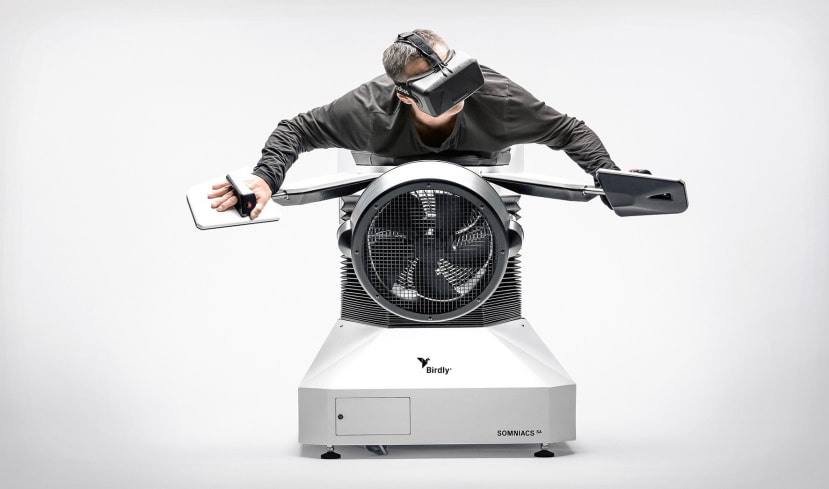Birdly - Making the Dream of Flying a Virtual Reality
Follow articleHow do you feel about this article? Help us to provide better content for you.
Thank you! Your feedback has been received.
There was a problem submitting your feedback, please try again later.
What do you think of this article?
How did you come up with the idea of building a simulator that lets people fly?
We wanted to do research on how immersion in virtual reality can be expanded to involve the entire body. To do that, we needed a fictional starting situation; usually, simulators just simulate machines like a tractor or an aeroplane. We wanted to build a simulator where you feel like a different creature and don’t notice that you’re operating a machine. From a design perspective, I found flying to be extremely interesting because it’s one of humanity’s most emotional dreams, and I’ve been involved in it a lot myself through paragliding and drone flights.
And how did you actually start the project?It’s funny, while I was thinking about these ideas, a bird advocacy group contacted me. They wanted to set up an exhibition about bird flight. So we started a project with the goal of being able to fly like a bird with help from virtual reality. The important thing was to involve as many senses as possible. Virtual reality usually addresses the eyes and ears, but I was determined to include sensomotoric and tactile experiences. So we got to work with a small team and put together the first prototype. How does the system work?The user lies on his belly on a machine that has three degrees of freedom. It can go up and down, forward and back, and can tip to the side when it takes a curve. The arms are attached to wings that the user can flap to move forward. Steering is done with the wrists; we made a conscious choice in favour of very intuitive steering since many people have limited motor skills and we can’t expect the coordination of a drummer. The user also wears VR glasses and headphones and faces into a headwind produced by a fan. For the headwind, we chose fans from ebm-papst because their speed can be adjusted to simulate different flight speeds. They’re also extremely quiet. Simulating wind plays a crucial role for the experience with the simulator. Along with visual impressions, the wind or wind resistance is a very important way for people to experience speed. Our senses pick that up through our skin and our hair. |
|
What kind of feedback have you received about your prototype?
It was put into service for the first time at the exhibition by the bird advocacy group in 2014. Guests got to fly as red kites through the kite’s natural habitat, and the feedback was entirely positive. Then we got the opportunity to present the project in Silicon Valley, which was also a great success. That was at the time when VR wasn’t really on the market yet, so the timing was really good. Other invitations followed, for example to the Sundance Festival, to research conferences and the Cannes Film Festival.
Were you still able to manage all that from the university?
Not really; that’s why we founded a separate company called Somniacs in 2015. The name is a combination of “somnia,” which stands for dreaming or sleeping, and “maniacs” because you have to be a bit crazy to do something like this. In 2016 we began commercial production of the simulator, which we now call “Birdly.” Our customers primarily include research museums working in fields like ornithology, natural history and technology. But entertainment parks are slowly putting out their feelers toward VR and getting interested in our product.
What kind of environments can customers fly in?
That depends on the customers. We’re flexible because we develop both the hardware and the software completely on our own. For most simulations, we’ve moved from the red kite to the eagle because it simply works better internationally. Besides natural landscapes, we quickly set up cities like New York and San Francisco, and we want to do that more in the future. Flying through the urban jungle as a bird is a much different kind of kick than gliding over fields and trees.
How much are you still involved with Somniacs today?
I juggle things a bit to balance my work in the company and at the university. I’ve also made some changes to the subject area that I lead. The master’s program is now strongly focused on immersive experiences because I believe that’s a huge and interesting market. It’s also an exciting social and technological phenomenon. And it’s not only about VR, it’s also about augmented reality, overlaying reality with virtual elements.
Besides design and conception, such ideas need a lot of technical expertise. What role does that play for you?
Especially at a design school, it’s important to me that people get insights into the technology — not just as an end in itself or a way to solve problems but as a means of expression. When I use technology, I can solve a problem like getting from A to B, but I can also shape the experience of travel, I can define how I get from A to B. That takes both: technology and design. With respect to Birdly, I really like a quote from the aviation pioneer Otto Lilienthal. It goes roughly, “Inventing a flying machine doesn’t mean much. Making one means more, but flying one is what really matters.” It’s simply about the feeling of flight, everything else is secondary.



 Max Rheiner, head of the master’s degree program for design interaction at the Zurich University of the Arts.
Max Rheiner, head of the master’s degree program for design interaction at the Zurich University of the Arts.